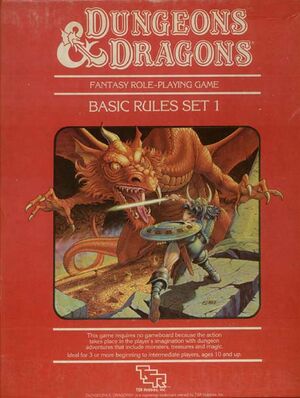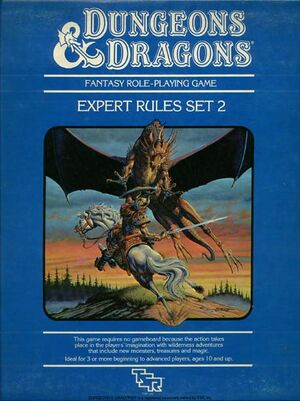Dungeons & Dragons
| Dungeons & Dragons | ||
|---|---|---|
 |
||
| RPG published by Wizards of the Coast (TSR originally) |
||
| Authors | Gary Gygax Dave Arneson |
|
| First Publication | 1974 (D&D Original) 1977 (D&D 1st Revision) 1977–79 (AD&D 1st Edition) 1981 (D&D 2nd Revision) 1983-1986 (D&D 3rd Revision) 1989 (AD&D 2nd Edition) 1991 (D&D 4th Revision) 2000 (D&D 3rd Edition) 2003 (D&D v.3.5) 2008 (D&D 4th Edition) 2014 (D&D 5th Edition) |
|
Dungeons & Dragons began as a crossover project by Gary Gygax and Dave Arneson in the early 1970s. Arneson's concept was to take the individual hero from Chainmail and tell his story. Gygax and Arneson collaborated on a project to realize this goal, and at Gen Con in 1974, they sold copies of the resulting game, Dungeons & Dragons. The game contained three small books in a brown box with white labels. (People often confuse the nearly identical white box (1978) with the actual original) The White Box was labeled with Original Collectors Edition to differentiate it from the newer Basic set being released around that time. In any case, this spawned the roleplaying game genre as we know it.
Versions
Original Dungeons & Dragons

Posthumously named, Dungeons & Dragons was directly linked to Chainmail in many ways. The Chainmail books even fit in the box. By adding multiple hero types to play and focusing on the aspect of the individual rather than the unit of the army, Gygax and Arneson kickstarted the Role Playing Game industry. People were no longer content to read tales of high fantasy in a book, not when they could control what the characters did! Dungeons & Dragons was released as a core set of 3 books and supplements were to follow later.
Dungeons & Dragons Contents
- Men & Magic - Allowed you to create a character and to learn the magic system.
- Monsters & Treasure - Pretty much exactly that. Rules for monster encounters and appropriate rewards for such.
- Underworld & Wilderness Adventures - The meat and potatoes of exploring overland and dungeon.
- Reference sheets - A stapled collection of pages with cross referencing tables and charts on them.
Supplements
- Supplement I Greyhawk - Introduced Oerth, new classes and spells and items and optional rules.
- Supplement II Blackmoor - Introduced TONS of items and optional rules.
- Supplement III Eldritch Wizardry - A lot of new magic rules and classes
- Supplement IV Gods, Demi-Gods, & Heroes - Rules for immortals, more classes, introduced the Paladin class.
- Supplement V Swords & Spells: More combat and magic rules, more game mechanics. This would be incorporated into AD&D later.





Basic Dungeons & Dragons
While Gygax was busy making "Advanced" Dungeons & Dragons, a doctor named John Eric Holmes worked on the original rules (plus Supplement I) with the intention of producing a single volume as an introduction for beginners. Holmes' Basic D&D (1977) was to be followed in 1981 by Basic and Expert D&D, edited by Tom Moldvay. Between 1983 and 1985, Frank Mentzer turned out the BECMI series. While often derided as "Kiddie D&D", sales of the basic version exceeded those of the Advanced version for a few years. The system was a stepped system, meaning you could just buy the Basic book at a relatively low cost (around $7) and if you wanted to advance your character past level 3, you could buy the Expert books and so on. Each book in each set was available separately.
Basic Set
This had everything you needed for characters level 1-3. It included a Players book and a DMs book and a small adventure (Keep on the Borderlands). Some later printings ($7? try $20.) replaced this adventure with an unfinished one, where you try to avenge a foxy NPC cleric Aleena on her murderer, a Magic-user named Bargle. It is a continuation of the Players' tutorial solo adventure (which was good if you lacked friends, and also inspired adventure gamebooks and invisible ink adventures like M1 Blizzard Pass). Some printings had 3 hole punch in the books to allow people to keep them in a binder easily. It also included a set of faulty dice that you colored in with a crayon. The books only printed material relevant for characters from levels 1-3 and so were much smaller than the average RPG book. This allowed them to be sold cheaply. You could play as a Dwarf (fighter with detection abilities but limited weapon selection), an Elf (armored fighter/magic-user, great at 1st level but takes forever to go up any higher), Halfing (a kinda fighter/thief but not really), Fighter, Cleric (no spells at level 1), Magic-User (hope you don't get hit), or Thief. Your alignment choices were Lawful, Neutral, or Chaotic. "Evil" was just a term of abuse.
Expert Set
This allowed you to advance from level 4 to level 14.
It came with another module (X1 Isle of Dread) and another set of dice.
It added a few more rules and more material relevant to characters of mid level.
Added combat rules for charging, using mount lances, or setting a spear to receive a charge. Introduced monsters with multiple attacks that could drain 2 levels per attack, instant kill poisons, and other things that made us hate our DM.
Demi-human characters (Elf, Dwarf, and Halfling) could not advance in level past this set, although by the end of it they had impressive saves and fair hit points. Their fighting ability continued to improve in later sets, so you weren't totally boned for playing subhuman filth.
Companion Set
Levels 15-25 were covered here.
If you bought the box set you got another set of dice as well, say some people, but I never got any.
Higher level magic, more monsters and such. Rules for tricking out your Lawful Fighter as a Paladin, your Chaotic Fighter into a sort of anti-paladin named an Avenger, your Neutral Cleric into a Druid, etc. The DMs' book included two mini adventures- a tournament featuring a knight named Sir Guy de Gax, and a pit-fighting adventure that forbade spellcasting.
Master Set
Levels 26-36.
This was for super high level campaigns.
The largest and nastiest monsters, the most powerful spells and rules for even running your own settlements. The players' book added about 20 overpowered polearms with pictures of every one, so you had no excuse for not knowing what a Lochaber Axe is. The "Roll to Hit" tables were extended out to show what was needed to hit AC -20 (of all things). Hope you packed your magical bonuses! There were rules for making a Thief into an Assassin, which you could then never play, for it was Evil (tm). Although some people can't find those rules in their copy, only finding "Headsmen" and "Thug" monster-type NPCs for the DM to use. There were epic quests to become the greatest of your class, including one called "the Polymath", where your Magic-User had to advance to level 36 in each of the other classes to become a 36/36/36/36 everything.
Box set came with another set of the cheap, easily destroyed Crayola Dice, unless you were me.
Immortals Set
For when levels mean precisely dick.
This has rules for gods. It has to, who else is going to stand up to you?
Another set of dice in this box, along with writeups on classical gods of mythology.
D&D Rules Cyclopedia
The rules Cyclopedia essentially was a compiled version of all the rules in the first four Basic D&D sets. The Immortals Set was reworked into the book Wrath of the Immortals. There were minor rule tweaks, but nothing drastic.
The Dungeons and Dragons Game

This box set was a comprehensive guide to roleplaying. It came with Dice, a map, a detailed book that stepped you through an adventure to generate your character and learn the fundamentals of role-play. (Xanzer Tem's dungeon)


